|
|
|
| |
|
|
| |
Cluny Cottages |
|
| |
| |
Built
in the early 1830’s, the cottages, formerly
the Preventive Houses where the King’s Men,
the forerunners of the customs and excise men
lived, are now called Cluny Cottages. Built with
stones from the local quarry, the red granite
lintels came from nearby Stirling Hill.
Slates for the roofs were shipped in by schooner
from Wales and carried up from the shore by the
women of the village in creels strapped to their
backs. Each of the seven single storey cottages
originally consisted of two rooms and an outside
toilet. A staircase separated the two rooms and
led to a loft.
The two storey house at the east end of the row
is reputed to have been the Collieston home of
Thomas Blake Glover, the 'Scottish Samurai', whose
father was head of the Coastguard Station in Collieston
from 1847 to 1849. |
| |
|
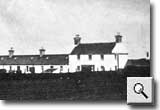 |
| |
|
|
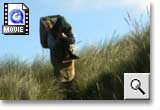 |
| At
the fishing |
| |
Towards
the end of the 19th Century Collieston was one
of the most prosperous fishing communities on
the NE coast of Scotland. About 50 open decked
yawls, manned by some 200 fishermen, were fishing
out of the village. “The Lang Lines”
is a video reconstruction of aspects of this
period.
|
|
|
|
| |
|
|
| |
George
Ritchie's boat sinks |
|
| |
| |
In
the summer of 1890. George Ritchie, John Walker
Ritchie his son, and 15-year-old Alexander Stott
drowned when their boat sank near the entrance
to Collieston harbour.
The boat was spotted by the crew of two yawls
sailing along with full sail set, about half a
mile off Collieston, heading for shore. Suddenly
the boat disappeared and the fishermen quickly
manned their boats and set off to the spot where
the craft had gone down but there was no sign
of survivors or wreckage.
The fruitless search continued all day but it
was not until two days later that the body of
John Walker Ritchie was recovered from the sea.
He was subsequently laid to rest in the churchyard
at Slains. The bodies of George Ritchie and Alexander
Stott were never found.
|
| |
|
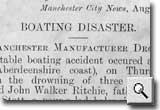 |
| |
|
|
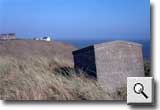 |
| Pier
construction |
| |
| The
concrete 'hut' is a reminder of the construction
of the Pier, which was built in 1894. Still standing
at a slant at the top of the Brae on the south
side of Perthudden, this curious structure was
built to house the explosives used in the Pier
work. |
| |
| For
safety’s sake the explosives were transported
to the site by boat from Perthudden rather than
being carted through the village. Looking at the
Brae on the north of Perthudden, Slains Lodge
the former Whiteness Hotel is clearly visible.
|
| |
To the right of Slains Lodge is a white washed cottage facing out to sea, formerly the lookout post of the Collieston Auxiliary Coastguard Company. |
|
|
| |
|
|
| |
Looking
from the high ground above the quarry in Cransdale,
towards the north side of Collieston Pier whilst
it was under construction.
The North and South entrances where the fishing
boats entered or left before the Pier was completed
are visible as are the rock formations on which
the Pier was built. A crane, used in the construction,
can be seen on the right of the picture.
In the foreground fish, probably cod or ling,
are drying on racks. Beyond the Pier Slains Lodge,
formerly known as Whiteness Hotel, is clearly
identifiable on the cliff top.
|
|
|
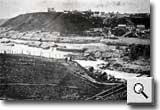 |
| |
|
|
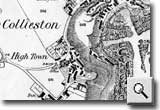 |
Collieston
map |
|
| |
A
map of Collieston in 1870. The quarry overlooks
Tarness Haven, now known as Cransdale. The houses
in the Low Town area are indicated nestling round
the rocky foreshore and natural harbour. Clearly
visible is the harbour’s north entrance,
through the Black Rig, which was later blocked
by the construction of the Pier in 1894.
In the High Town area of the village the houses,
including the Post Office, are huddled together
on the cliff top overlooking the harbour. On the
perimeter of the High Town stands the Whiteness
Inn (Hotel) while to the south, situated on the
eastern side of the Sand Loch is the Coastguard
Station with its Watch House and Boat House indicated
on the nearby cliffs.
Various caves, rocks, inlets and bays along the
coast are clearly identified from Hell’s
Lum in the north to Perthudden in the south.
|
| |
|
|
|
| |
| |
|
|
| |
Smuggling |
|
| |
| |
It
was in 1801 that Malcolm Gillespie, a zealous customs
officer. was appointed to Collieston. He later died
on the gallows after being found guilty of forgery and
in an effort to save his life, his friends published
an account of his exploits against the smugglers in
the vain hope that it would gain him clemency. This
account shows that when Malcolm Gillespie was posted
to Collieston, upwards of 1000 ankers of holland gin
were landed at Collieston every month. The account states,
‘the illicit trade was carried on by people of
considerable stock and influence and it required great
resolution and exertion to attack and suppress such
a formidable and powerful company’.
Malcolm Gillespie left Collieston in 1807 believing
that he had conquered the smugglers but as can be seen
from Geordie Sangster’s account of a landing in
1814 this was not the case.
Malcolm Gillespie’s list of the seizures which
he made during the 6 years he was in Collieston indicates
by the number of stills seized that the people of Collieston
were distilling their own spirits as well as importing
them. The horse and carts seized suggests that the country
folk as well as the fishers were involved in the smuggling
trade. The likely set up would be that the fishers brought
the contraband ashore and possibly stored it whilst
the farmers with their contacts in the hinterland would
market and distribute it.
Geordie Sangster’s tale as told to James Dalgarno
in 1842 is a very good illustration of how smuggling
was a joint enterprise within the community.
‘The largest consignment of gin on record was
in the fall of the year 1814. The Dutchmen made a landing
at the shore of Collieston, Cransdale, Port Thuddan
and Old Slains Castle. The more daring of the Dutch
crews jumped on shore armed with cutlasses, pistols
and some with boat guns to protect the villagers and
others of the landward parts in hiding away the ankers
in the various concealments by sea and land. While the
remaining crews filled the creels and sacks of formidable
men and women from the boats. Andrew King, skipper of
the boat Nancy of Collieston took one of the armed desperados
aside and told him that ha and his crew had a dread
of being watched in carrying off the prize to the concealment
at Whiteness being aware that there was one, if not
more, gaugers at the Inn. On giving them instructions
to do their duty without fear, the Dutchman took a cask
below his arm, went to the Inn, and placing it on the
floor took a hatchet which he had hooked on to his leather
belt, broke open the head of the cask, and taking it
by the chime between his finger and thumb he placed
it on the kitchen dresser with the same apparent ease
as a common mortal would have lifted the empty cask.
The inmates were awe struck at the process of only a
few minutes. The chief addressing himself to the landlord,
Baron Bailie, of the village said that he had brought
a gift for the good of the house, and filling a horn
drank to the host and hostess. While doing these honours
the gaugers moved out by stealth, but were immediately
followed by the mysterious stranger who had made up
his mind to keep them prisoners until the traffic was
over. A smart altercation being heard on the ‘toon
loan’ the Bailie rushed out to prevent blood shed
if that was possible, but found only one of the two
that went out. The Dutch chief told the Bailie that
he came to protect the villagers, and that the one under
his charge, he would lock up in the Inn for the night
and would like the ‘bird’ that had flown
under his protection also. The gauger taken in charge
seeing the folly of wrestling with a fearless Dutchman
bristling with armour calmly submitted to the ordeal
and on being marched in was locked up, the chief taking
good care that the window of the cell was properly secured.
The landlord seeing that the chief really meant what
he said took him aside and handed him the key as a guarantee
that no one could release the exciseman but himself.
It was soon spread abroad in the village that one of
the Excisemen had fled and no one seemed to know where
he had gone. The chief with the aid of one of his crew
searched every house and bed above and below to the
terror of the wives and children of the fishermen but
without any result. As a last recourse they went to
the links adjoining to the Sandloch and over the site
where the Preventive Station now stands, shouting and
threatening all the way, but were only responded to
by the plaintive cries of the curlew and plover frightened
from their marshy lair. The chief and his assistant
on returning at an early hour in the morning found that
the gin had been nearly secured and that they would
soon be ready to embark, made a farewell and a business
visit to the Baillie and James Dickie, the accountant.
“Nae man can tether time nor tide”
A weird shout from the Dutchman reverberating from the
shores of Cransdale and Porthudden answered by another
from the shore of Colllieston, told that it was time
for every one belonging to the craft to be on board.
Plying their oars with great verve and using nautical
terms long since obsolete, they were soon out of site
and hearing. An over supply of traffic caused the holders
to store it away in turnip and potato furrows while
Mr Gray of Knaps Leask put a large supply of his own
and others into a large feal dyke being built.
But on the whole the work was accomplished, the morning
was far advanced, the ploughman was too late for his
routine of morning labour, and the fisherman had lost
a tide. Acting on the advice of the Dutch Captain the
Bailie released the Exciseman in excellent time for
breakfast, but his guest seemed ill at ease after the
severe ordeal and the more so that his friend and companion
in business had not turned up. “Earth has its
angels too”. The sympathy and hospitality of the
lady of the house, however was the means of softening
his heart and in some measure made him forget the degradation.
The village was quiet. The men who had done duty the
night before were in bed and some of the lads and mothers
were engaged in baiting the lines, while old Jamie Buthly
was leaning on the gable of his house. with his hands
deep into his trouser pockets taking weather observations.
Seeing a smart looking young man suddenly leaving the
house of a neighbour he became curious to know who he
was and why such haste. On making enquiry he found that
it was the missing Exciseman who had fled from justice
the night before and put himself under the protection
of Jenny Ritchie who in haste, but with great presence
of mind placed him on a pile of dried fish, and covering
him over with a large tarpauline told him not to stir
without her leave if he valued his life. Jenny said
that she “wus fleyt for the ruffin mischiven the
bonny young lad, he was some mither’s bairn."
At a pretty early hour of the day a confidential messenger
was sent by Provost Chalmers, Ellon to inform James
Dickie that a spy and an informant, under pay from his
quarter had been in Ellon and was on the way to Oldmeldrum,
the headquarters of the Excise. It was the nature of
James Dickie to take a calm and deliberate view of things
in every day life. He called on the Baillie and after
consulting together, they came to the conclusion that
they should have a full meeting of the holder of gin
and that notice should immediately be given to the traders
in the landwards parts of the parish. Messengers were
forthwith sent to the respective parties with instructions
to attend a meeting that evening on urgent business.
Prior to the arrival of John Anderson, Kirkton, John
Henderson, Crawlay and George Gray, Knaps Leask , James
and the Bailie had thought it over and wrought out a
scheme which they were in hopes would meet with the
approval of their landward friends viz to find out some
active and willing party who would undertake to way
lay the Excisemen on the following morning on the road
from Ellon with casks of gin. Better they thought to
lose a few casks than a whole store. The brethren met
at the hour appointed and in partaking of the hospitality
of the Bailie it was agreed to follow out the proposal
indicated and a deputation was chosen there and then
to wait on a likely party to carry out the business.
Early on the following morning George Hardy, Knapperna,
light of heart and foot, put his trusty mare into harness
and four casks of gin into corn sacks packed with straw
and was on the road with the merchant goods, purporting
to be for Provost Chalmers, Ellon, before his neighbours
were astir. George said his mare was slow but sure,
and by the time that he got to the Brig o’ Forvie
the morning sky was reflecting on the river Ythan. On
reaching the policies of Bilba Park, Logie Buchan he
rested his mare before venturing on Carr’s Brae.
Twas a moment of suspense to George when he saw two
Excisemen approaching with determined steps on the route
as he thought to Collieston. Looking suspicious at the
contents of the cart., they asked him where he was bound
for but without exchanging a word he jumped the stone
wall and bounded off like a stag through the plantations
leaving the gentlemen in charge of the mare and booty.
In the belief that they were giving chase he ran on
a straight line over hedges and ditches till he came
to the boat house at Logie. Knocking at the door and
calling on the boatman for immediate action he was soon
floated beyond the reach of the Government Officials
and had the protection, if need were of the flowing
tide.. George seeing no one in pursuit on either side
of the river made up his mind to take an easy walk and
a rest at the boat house of Newburgh till the tide receded.
The news of the capture had not been heard of on the
Foveran side of the river and George was anything but
communicative on private business.
‘Nae
man can tether time nor tide
The hour approaches Tam maun ride’
At low water George joined the busy mussel bait gatherers
from Collieston on their way home through the Links
of Forvie with heavy laden creels. On reaching Whiteness
he was received with open arms by the Bailie and Jeems
Dickie, and was thanked very cordially for carrying
out the scheme to the very letter. On taking leave of
his friends he was rewarded and the promise of a more
substantial payment after a full meeting of traders.
The talk of the day was of the missing mare. George
however was reticent. But when a Messenger at Arms appeared
on the ground bristling with authority and a warrant
from the Sheriff of Aberdeenshire to dispose of the
confiscated property on the square of Ellon, giving
day and date, all doubts were dispelled. On the following
Sunday after sermon the sale was ‘skried’
at the bell doors of the Kirks of Ellon, Logie and Slains
to wondering audiences. The day of the sale came with
but few bidders. The property was knocked out at the
first bid and at a low figure and by a deft process
the mare with harness and cart was restored to the owner
that night none the worse for changing hands.
With the forming of the Coast Guard in 1822 and the
government substantially reducing the duty on imported
goods, smuggling became more difficult and less attractive
so the illicit trade gradually died out and had ceased
altogether by the middle of the 19th century.'
Reprinted by kind permission of the University of Aberdeen
|
Foreign Seizures while stationed at Collieston.
British Seizures while stationed at Collieston.
| 17 stills 20 gallons aqua 900 gallons
wash |
|
| |
| |
|
|
 |
|
| ....copyright
collieston's century 2003 |
|